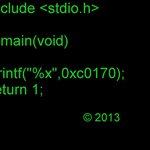mbed library sources. Supersedes mbed-src.
Dependents: Nucleo_Hello_Encoder BLE_iBeaconScan AM1805_DEMO DISCO-F429ZI_ExportTemplate1 ... more
targets/TARGET_NUVOTON/TARGET_NANO100/device/StdDriver/nano100_gpio.h
- Committer:
- AnnaBridge
- Date:
- 2017-10-02
- Revision:
- 174:b96e65c34a4d
File content as of revision 174:b96e65c34a4d:
/**************************************************************************//**
* @file gpio.h
* @version V1.00
* $Revision: 7 $
* $Date: 14/12/01 10:30a $
* @brief Nano100 series GPIO driver header file
*
* @note
* Copyright (C) 2014 Nuvoton Technology Corp. All rights reserved.
*****************************************************************************/
#ifndef __GPIO_H__
#define __GPIO_H__
#ifdef __cplusplus
extern "C"
{
#endif
/** @addtogroup NANO100_Device_Driver NANO100 Device Driver
@{
*/
/** @addtogroup NANO100_GPIO_Driver GPIO Driver
@{
*/
/** @addtogroup NANO100_GPIO_EXPORTED_CONSTANTS GPIO Exported Constants
@{
*/
#define GPIO_PIN_MAX 16 /*!< Specify Maximum Pins of Each GPIO Port */
/*---------------------------------------------------------------------------------------------------------*/
/* PMD Constant Definitions */
/*---------------------------------------------------------------------------------------------------------*/
#define GPIO_PMD_INPUT 0x0UL /*!< Input Mode */
#define GPIO_PMD_OUTPUT 0x1UL /*!< Output Mode */
#define GPIO_PMD_OPEN_DRAIN 0x2UL /*!< Open-Drain Mode */
/*---------------------------------------------------------------------------------------------------------*/
/* GPIO Interrupt Type Constant Definitions */
/*---------------------------------------------------------------------------------------------------------*/
#define GPIO_INT_RISING 0x00010000UL /*!< Interrupt enable by Input Rising Edge */
#define GPIO_INT_FALLING 0x00000001UL /*!< Interrupt enable by Input Falling Edge */
#define GPIO_INT_BOTH_EDGE 0x00010001UL /*!< Interrupt enable by both Rising Edge and Falling Edge */
#define GPIO_INT_HIGH 0x01010000UL /*!< Interrupt enable by Level-High */
#define GPIO_INT_LOW 0x01000001UL /*!< Interrupt enable by Level-Level */
/*---------------------------------------------------------------------------------------------------------*/
/* IMD Constant Definitions */
/*---------------------------------------------------------------------------------------------------------*/
#define GPIO_IMD_EDGE 0UL /*!< IMD Setting for Edge Trigger Mode */
#define GPIO_IMD_LEVEL 1UL /*!< IMD Setting for Edge Level Mode */
/*---------------------------------------------------------------------------------------------------------*/
/* DBNCECON Constant Definitions */
/*---------------------------------------------------------------------------------------------------------*/
#define GPIO_ICLK_ON 0x00000020UL /*!< DBNCECON setting for all IO pins edge detection circuit is always active after reset */
#define GPIO_ICLK_OFF 0x00000000UL /*!< DBNCECON setting for edge detection circuit is active only if IO pin corresponding GPIOx_IEN bit is set to 1 */
#define GPIO_DBCLKSRC_IRC10K 0x00000010UL /*!< DBNCECON setting for de-bounce counter clock source is the internal 10 kHz */
#define GPIO_DBCLKSRC_HCLK 0x00000000UL /*!< DBNCECON setting for de-bounce counter clock source is the internal HCLK */
#define GPIO_DBCLKSEL_1 0x00000000UL /*!< DBNCECON setting for sampling cycle = 1 clocks */
#define GPIO_DBCLKSEL_2 0x00000001UL /*!< DBNCECON setting for sampling cycle = 2 clocks */
#define GPIO_DBCLKSEL_4 0x00000002UL /*!< DBNCECON setting for sampling cycle = 4 clocks */
#define GPIO_DBCLKSEL_8 0x00000003UL /*!< DBNCECON setting for sampling cycle = 8 clocks */
#define GPIO_DBCLKSEL_16 0x00000004UL /*!< DBNCECON setting for sampling cycle = 16 clocks */
#define GPIO_DBCLKSEL_32 0x00000005UL /*!< DBNCECON setting for sampling cycle = 32 clocks */
#define GPIO_DBCLKSEL_64 0x00000006UL /*!< DBNCECON setting for sampling cycle = 64 clocks */
#define GPIO_DBCLKSEL_128 0x00000007UL /*!< DBNCECON setting for sampling cycle = 128 clocks */
#define GPIO_DBCLKSEL_256 0x00000008UL /*!< DBNCECON setting for sampling cycle = 256 clocks */
#define GPIO_DBCLKSEL_512 0x00000009UL /*!< DBNCECON setting for sampling cycle = 512 clocks */
#define GPIO_DBCLKSEL_1024 0x0000000AUL /*!< DBNCECON setting for sampling cycle = 1024 clocks */
#define GPIO_DBCLKSEL_2048 0x0000000BUL /*!< DBNCECON setting for sampling cycle = 2048 clocks */
#define GPIO_DBCLKSEL_4096 0x0000000CUL /*!< DBNCECON setting for sampling cycle = 4096 clocks */
#define GPIO_DBCLKSEL_8192 0x0000000DUL /*!< DBNCECON setting for sampling cycle = 8192 clocks */
#define GPIO_DBCLKSEL_16384 0x0000000EUL /*!< DBNCECON setting for sampling cycle = 16384 clocks */
#define GPIO_DBCLKSEL_32768 0x0000000FUL /*!< DBNCECON setting for sampling cycle = 32768 clocks */
/** Define GPIO Pin Data Input/Output. It could be used to control each I/O pin by pin address mapping.
* Example 1:
*
* PA0 = 1;
*
* It is used to set PA0 to high;
*
* Example 2:
*
* if (PA0)
* PA0 = 0;
*
* If PA0 pin status is high, then set PA0 data output to low.
*/
#define GPIO_PIN_ADDR(port, pin) (*((volatile uint32_t *)((GPIO_PIN_DATA_BASE+(0x40*(port))) + ((pin)<<2))))
#define PA0 GPIO_PIN_ADDR(0, 0) /*!< Specify PA0 Pin Data Input/Output */
#define PA1 GPIO_PIN_ADDR(0, 1) /*!< Specify PA1 Pin Data Input/Output */
#define PA2 GPIO_PIN_ADDR(0, 2) /*!< Specify PA2 Pin Data Input/Output */
#define PA3 GPIO_PIN_ADDR(0, 3) /*!< Specify PA3 Pin Data Input/Output */
#define PA4 GPIO_PIN_ADDR(0, 4) /*!< Specify PA4 Pin Data Input/Output */
#define PA5 GPIO_PIN_ADDR(0, 5) /*!< Specify PA5 Pin Data Input/Output */
#define PA6 GPIO_PIN_ADDR(0, 6) /*!< Specify PA6 Pin Data Input/Output */
#define PA7 GPIO_PIN_ADDR(0, 7) /*!< Specify PA7 Pin Data Input/Output */
#define PA8 GPIO_PIN_ADDR(0, 8) /*!< Specify PA8 Pin Data Input/Output */
#define PA9 GPIO_PIN_ADDR(0, 9) /*!< Specify PA9 Pin Data Input/Output */
#define PA10 GPIO_PIN_ADDR(0, 10) /*!< Specify PA10 Pin Data Input/Output */
#define PA11 GPIO_PIN_ADDR(0, 11) /*!< Specify PA11 Pin Data Input/Output */
#define PA12 GPIO_PIN_ADDR(0, 12) /*!< Specify PA12 Pin Data Input/Output */
#define PA13 GPIO_PIN_ADDR(0, 13) /*!< Specify PA13 Pin Data Input/Output */
#define PA14 GPIO_PIN_ADDR(0, 14) /*!< Specify PA14 Pin Data Input/Output */
#define PA15 GPIO_PIN_ADDR(0, 15) /*!< Specify PA15 Pin Data Input/Output */
#define PB0 GPIO_PIN_ADDR(1, 0) /*!< Specify PB0 Pin Data Input/Output */
#define PB1 GPIO_PIN_ADDR(1, 1) /*!< Specify PB1 Pin Data Input/Output */
#define PB2 GPIO_PIN_ADDR(1, 2) /*!< Specify PB2 Pin Data Input/Output */
#define PB3 GPIO_PIN_ADDR(1, 3) /*!< Specify PB3 Pin Data Input/Output */
#define PB4 GPIO_PIN_ADDR(1, 4) /*!< Specify PB4 Pin Data Input/Output */
#define PB5 GPIO_PIN_ADDR(1, 5) /*!< Specify PB5 Pin Data Input/Output */
#define PB6 GPIO_PIN_ADDR(1, 6) /*!< Specify PB6 Pin Data Input/Output */
#define PB7 GPIO_PIN_ADDR(1, 7) /*!< Specify PB7 Pin Data Input/Output */
#define PB8 GPIO_PIN_ADDR(1, 8) /*!< Specify PB8 Pin Data Input/Output */
#define PB9 GPIO_PIN_ADDR(1, 9) /*!< Specify PB9 Pin Data Input/Output */
#define PB10 GPIO_PIN_ADDR(1, 10) /*!< Specify PB10 Pin Data Input/Output */
#define PB11 GPIO_PIN_ADDR(1, 11) /*!< Specify PB11 Pin Data Input/Output */
#define PB12 GPIO_PIN_ADDR(1, 12) /*!< Specify PB12 Pin Data Input/Output */
#define PB13 GPIO_PIN_ADDR(1, 13) /*!< Specify PB13 Pin Data Input/Output */
#define PB14 GPIO_PIN_ADDR(1, 14) /*!< Specify PB14 Pin Data Input/Output */
#define PB15 GPIO_PIN_ADDR(1, 15) /*!< Specify PB15 Pin Data Input/Output */
#define PC0 GPIO_PIN_ADDR(2, 0) /*!< Specify PC0 Pin Data Input/Output */
#define PC1 GPIO_PIN_ADDR(2, 1) /*!< Specify PC1 Pin Data Input/Output */
#define PC2 GPIO_PIN_ADDR(2, 2) /*!< Specify PC2 Pin Data Input/Output */
#define PC3 GPIO_PIN_ADDR(2, 3) /*!< Specify PC3 Pin Data Input/Output */
#define PC4 GPIO_PIN_ADDR(2, 4) /*!< Specify PC4 Pin Data Input/Output */
#define PC5 GPIO_PIN_ADDR(2, 5) /*!< Specify PC5 Pin Data Input/Output */
#define PC6 GPIO_PIN_ADDR(2, 6) /*!< Specify PC6 Pin Data Input/Output */
#define PC7 GPIO_PIN_ADDR(2, 7) /*!< Specify PC7 Pin Data Input/Output */
#define PC8 GPIO_PIN_ADDR(2, 8) /*!< Specify PC8 Pin Data Input/Output */
#define PC9 GPIO_PIN_ADDR(2, 9) /*!< Specify PC9 Pin Data Input/Output */
#define PC10 GPIO_PIN_ADDR(2, 10) /*!< Specify PC10 Pin Data Input/Output */
#define PC11 GPIO_PIN_ADDR(2, 11) /*!< Specify PC11 Pin Data Input/Output */
#define PC12 GPIO_PIN_ADDR(2, 12) /*!< Specify PC12 Pin Data Input/Output */
#define PC13 GPIO_PIN_ADDR(2, 13) /*!< Specify PC13 Pin Data Input/Output */
#define PC14 GPIO_PIN_ADDR(2, 14) /*!< Specify PC14 Pin Data Input/Output */
#define PC15 GPIO_PIN_ADDR(2, 15) /*!< Specify PC15 Pin Data Input/Output */
#define PD0 GPIO_PIN_ADDR(3, 0) /*!< Specify PD0 Pin Data Input/Output */
#define PD1 GPIO_PIN_ADDR(3, 1) /*!< Specify PD1 Pin Data Input/Output */
#define PD2 GPIO_PIN_ADDR(3, 2) /*!< Specify PD2 Pin Data Input/Output */
#define PD3 GPIO_PIN_ADDR(3, 3) /*!< Specify PD3 Pin Data Input/Output */
#define PD4 GPIO_PIN_ADDR(3, 4) /*!< Specify PD4 Pin Data Input/Output */
#define PD5 GPIO_PIN_ADDR(3, 5) /*!< Specify PD5 Pin Data Input/Output */
#define PD6 GPIO_PIN_ADDR(3, 6) /*!< Specify PD6 Pin Data Input/Output */
#define PD7 GPIO_PIN_ADDR(3, 7) /*!< Specify PD7 Pin Data Input/Output */
#define PD8 GPIO_PIN_ADDR(3, 8) /*!< Specify PD8 Pin Data Input/Output */
#define PD9 GPIO_PIN_ADDR(3, 9) /*!< Specify PD9 Pin Data Input/Output */
#define PD10 GPIO_PIN_ADDR(3, 10) /*!< Specify PD10 Pin Data Input/Output */
#define PD11 GPIO_PIN_ADDR(3, 11) /*!< Specify PD11 Pin Data Input/Output */
#define PD12 GPIO_PIN_ADDR(3, 12) /*!< Specify PD12 Pin Data Input/Output */
#define PD13 GPIO_PIN_ADDR(3, 13) /*!< Specify PD13 Pin Data Input/Output */
#define PD14 GPIO_PIN_ADDR(3, 14) /*!< Specify PD14 Pin Data Input/Output */
#define PD15 GPIO_PIN_ADDR(3, 15) /*!< Specify PD15 Pin Data Input/Output */
#define PE0 GPIO_PIN_ADDR(4, 0) /*!< Specify PE0 Pin Data Input/Output */
#define PE1 GPIO_PIN_ADDR(4, 1) /*!< Specify PE1 Pin Data Input/Output */
#define PE2 GPIO_PIN_ADDR(4, 2) /*!< Specify PE2 Pin Data Input/Output */
#define PE3 GPIO_PIN_ADDR(4, 3) /*!< Specify PE3 Pin Data Input/Output */
#define PE4 GPIO_PIN_ADDR(4, 4) /*!< Specify PE4 Pin Data Input/Output */
#define PE5 GPIO_PIN_ADDR(4, 5) /*!< Specify PE5 Pin Data Input/Output */
#define PE6 GPIO_PIN_ADDR(4, 6) /*!< Specify PE6 Pin Data Input/Output */
#define PE7 GPIO_PIN_ADDR(4, 7) /*!< Specify PE7 Pin Data Input/Output */
#define PE8 GPIO_PIN_ADDR(4, 8) /*!< Specify PE8 Pin Data Input/Output */
#define PE9 GPIO_PIN_ADDR(4, 9) /*!< Specify PE9 Pin Data Input/Output */
#define PE10 GPIO_PIN_ADDR(4, 10) /*!< Specify PE10 Pin Data Input/Output */
#define PE11 GPIO_PIN_ADDR(4, 11) /*!< Specify PE11 Pin Data Input/Output */
#define PE12 GPIO_PIN_ADDR(4, 12) /*!< Specify PE12 Pin Data Input/Output */
#define PE13 GPIO_PIN_ADDR(4, 13) /*!< Specify PE13 Pin Data Input/Output */
#define PE14 GPIO_PIN_ADDR(4, 14) /*!< Specify PE14 Pin Data Input/Output */
#define PE15 GPIO_PIN_ADDR(4, 15) /*!< Specify PE15 Pin Data Input/Output */
#define PF0 GPIO_PIN_ADDR(5, 0) /*!< Specify PF0 Pin Data Input/Output */
#define PF1 GPIO_PIN_ADDR(5, 1) /*!< Specify PF1 Pin Data Input/Output */
#define PF2 GPIO_PIN_ADDR(5, 2) /*!< Specify PF2 Pin Data Input/Output */
#define PF3 GPIO_PIN_ADDR(5, 3) /*!< Specify PF3 Pin Data Input/Output */
#define PF4 GPIO_PIN_ADDR(5, 4) /*!< Specify PF4 Pin Data Input/Output */
#define PF5 GPIO_PIN_ADDR(5, 5) /*!< Specify PF5 Pin Data Input/Output */
/*@}*/ /* end of group NANO100_GPIO_EXPORTED_CONSTANTS */
/** @addtogroup NANO100_GPIO_EXPORTED_FUNCTIONS GPIO Exported Functions
@{
*/
/**
* @brief Clear GPIO Pin Interrupt Flag
*
* @param[in] gpio GPIO port. It could be \ref PA, \ref PB, \ref PC, \ref PD, \ref PE or \ref PF
* @param[in] u32PinMask The single or multiple pins of specified GPIO port
*
* @return None
*
* @details Clear the interrupt status of specified GPIO pin.
*/
#define GPIO_CLR_INT_FLAG(gpio, u32PinMask) ((gpio)->ISRC = u32PinMask)
/**
* @brief Disable Pin De-bounce Function
*
* @param[in] gpio GPIO port. It could be \ref PA, \ref PB, \ref PC, \ref PD, \ref PE or \ref PF
* @param[in] u32PinMask The single or multiple pins of specified GPIO port
*
* @return None
*
* @details Disable the interrupt de-bounce function of specified GPIO pin.
*/
#define GPIO_DISABLE_DEBOUNCE(gpio, u32PinMask) ((gpio)->DBEN &= ~u32PinMask)
/**
* @brief Enable Pin De-bounce Function
*
* @param[in] gpio GPIO port. It could be \ref PA, \ref PB, \ref PC, \ref PD, \ref PE or \ref PF
* @param[in] u32PinMask The single or multiple pins of specified GPIO port
*
* @return None
*
* @details Enable the interrupt de-bounce function of specified GPIO pin.
*/
#define GPIO_ENABLE_DEBOUNCE(gpio, u32PinMask) ((gpio)->DBEN |= u32PinMask)
/**
* @brief Disable I/O Digital Input Path
*
* @param[in] gpio GPIO port. It could be \ref PA, \ref PB, \ref PC, \ref PD, \ref PE or \ref PF
* @param[in] u32PinMask The single or multiple pins of specified GPIO port
*
* @return None
*
* @details Disable I/O digital input path of specified GPIO pin.
*/
#define GPIO_DISABLE_DIGITAL_PATH(gpio, u32PinMask) ((gpio)->OFFD |= (u32PinMask << 16))
/**
* @brief Enable I/O Digital Input Path
*
* @param[in] gpio GPIO port. It could be \ref PA, \ref PB, \ref PC, \ref PD, \ref PE or \ref PF
* @param[in] u32PinMask The single or multiple pins of specified GPIO port
*
* @return None
*
* @details Enable I/O digital input path of specified GPIO pin.
*/
#define GPIO_ENABLE_DIGITAL_PATH(gpio, u32PinMask) ((gpio)->OFFD &= ~(u32PinMask << 16))
/**
* @brief Disable I/O DOUT mask
*
* @param[in] gpio GPIO port. It could be \ref PA, \ref PB, \ref PC, \ref PD, \ref PE or \ref PF
* @param[in] u32PinMask The single or multiple pins of specified GPIO port
*
* @return None
*
* @details Disable I/O DOUT mask of specified GPIO pin.
*/
#define GPIO_DISABLE_DOUT_MASK(gpio, u32PinMask) ((gpio)->DMASK &= ~u32PinMask)
/**
* @brief Enable I/O DOUT mask
*
* @param[in] gpio GPIO port. It could be \ref PA, \ref PB, \ref PC, \ref PD, \ref PE or \ref PF
* @param[in] u32PinMask The single or multiple pins of specified GPIO port
*
* @return None
*
* @details Enable I/O DOUT mask of specified GPIO pin.
*/
#define GPIO_ENABLE_DOUT_MASK(gpio, u32PinMask) ((gpio)->DMASK |= u32PinMask)
/**
* @brief Get GPIO Pin Interrupt Flag
*
* @param[in] gpio GPIO port. It could be \ref PA, \ref PB, \ref PC, \ref PD, \ref PE or \ref PF
* @param[in] u32PinMask The single or multiple pins of specified GPIO port
*
* @retval 0 No interrupt at specified GPIO pin
* @retval 1 The specified GPIO pin generate an interrupt
*
* @details Get the interrupt status of specified GPIO pin.
*/
#define GPIO_GET_INT_FLAG(gpio, u32PinMask) ((gpio)->ISRC & u32PinMask)
/**
* @brief Set De-bounce Sampling Cycle Time
*
* @param[in] u32ClkSrc The de-bounce counter clock source. It could be \ref GPIO_DBCLKSRC_HCLK or \ref GPIO_DBCLKSRC_IRC10K
* @param[in] u32ClkSel The de-bounce sampling cycle selection. It could be \n
* \ref GPIO_DBCLKSEL_1, \ref GPIO_DBCLKSEL_2, \ref GPIO_DBCLKSEL_4, \ref GPIO_DBCLKSEL_8, \n
* \ref GPIO_DBCLKSEL_16, \ref GPIO_DBCLKSEL_32, \ref GPIO_DBCLKSEL_64, \ref GPIO_DBCLKSEL_128, \n
* \ref GPIO_DBCLKSEL_256, \ref GPIO_DBCLKSEL_512, \ref GPIO_DBCLKSEL_1024, \ref GPIO_DBCLKSEL_2048, \n
* \ref GPIO_DBCLKSEL_4096, \ref GPIO_DBCLKSEL_8192, \ref GPIO_DBCLKSEL_16384, \ref GPIO_DBCLKSEL_32768
*
* @return None
*
* @details Set the interrupt de-bounce sampling cycle time based on the debounce counter clock source. \n
* Example: \ref GPIO_SET_DEBOUNCE_TIME(\ref GPIO_DBCLKSRC_IRC10K, \ref GPIO_DBCLKSEL_4) \n
* It's meaning the De-debounce counter clock source is internal 10 KHz and sampling cycle selection is 4. \n
* Then the target de-bounce sampling cycle time is (2^4)*(1/(10*1000)) s = 16*0.0001 s = 1600 us,
* and system will sampling interrupt input once per 1600 us.
*/
#define GPIO_SET_DEBOUNCE_TIME(u32ClkSrc, u32ClkSel) (GPIO->DBNCECON = (GP_DBNCECON_DBCLK_ON_Msk | u32ClkSrc | u32ClkSel))
/**
* @brief Get GPIO Port IN Data
*
* @param[in] gpio GPIO port. It could be \ref PA, \ref PB, \ref PC, \ref PD, \ref PE or \ref PF
*
* @retval The specified port data
*
* @details Get the PIN register of specified GPIO port.
*/
#define GPIO_GET_IN_DATA(gpio) ((gpio)->PIN)
/**
* @brief Set GPIO Port OUT Data
*
* @param[in] gpio GPIO port. It could be \ref PA, \ref PB, \ref PC, \ref PD, \ref PE or \ref PF
* @param[in] u32Data GPIO port data
*
* @retval None
*
* @details Set the Data into specified GPIO port.
*/
#define GPIO_SET_OUT_DATA(gpio, u32Data) ((gpio)->DOUT = (u32Data))
/**
* @brief Disable Pin Pull-up resistor Function
*
* @param[in] gpio GPIO port. It could be \ref PA, \ref PB, \ref PC, \ref PD, \ref PE or \ref PF
* @param[in] u32PinMask The single or multiple pins of specified GPIO port
*
* @return None
*
* @details Disable the Pull-up resistor function of specified GPIO pin.
*/
#define GPIO_DISABLE_PULL_UP(gpio, u32PinMask) ((gpio)->PUEN &= ~u32PinMask)
/**
* @brief Enable Pin Pull-up resistor Function
*
* @param[in] gpio GPIO port. It could be \ref PA, \ref PB, \ref PC, \ref PD, \ref PE or \ref PF
* @param[in] u32PinMask The single or multiple pins of specified GPIO port
*
* @return None
*
* @details Enable the Pull-up resistor function of specified GPIO pin.
*/
#define GPIO_ENABLE_PULL_UP(gpio, u32PinMask) ((gpio)->PUEN |= u32PinMask)
/**
* @brief Toggle Specified GPIO pin
*
* @param[in] u32Pin Pxy
*
* @retval None
*
* @details Toggle the specified GPIO pint.
*/
#define GPIO_TOGGLE(u32Pin) ((u32Pin) ^= 1)
/**
* @brief Enable External GPIO interrupt 0
*
* @param[in] gpio GPIO port. It could be \ref PA, \ref PB, \ref PC, \ref PD, \ref PE or \ref PF
* @param[in] u32Pin The pin of specified GPIO port
* @param[in] u32IntAttribs The interrupt attribute of specified GPIO pin. It could be \n
* \ref GPIO_INT_RISING, \ref GPIO_INT_FALLING, \ref GPIO_INT_BOTH_EDGE, \ref GPIO_INT_HIGH, \ref GPIO_INT_LOW
*
* @return None
*
* @details This function is used to enable specified GPIO pin interrupt.
*/
#define GPIO_EnableEINT0 GPIO_EnableInt
/**
* @brief Disable External GPIO interrupt 0
*
* @param[in] gpio GPIO port. It could be \ref PA, \ref PB, \ref PC, \ref PD, \ref PE or \ref PF
* @param[in] u32Pin The pin of specified GPIO port. It could be 0 ~ 15
*
* @return None
*
* @details This function is used to enable specified GPIO pin interrupt.
*/
#define GPIO_DisableEINT0 GPIO_DisableInt
/**
* @brief Enable External GPIO interrupt 1
*
* @param[in] gpio GPIO port. It could be \ref PA, \ref PB, \ref PC, \ref PD, \ref PE or \ref PF
* @param[in] u32Pin The pin of specified GPIO port
* @param[in] u32IntAttribs The interrupt attribute of specified GPIO pin. It could be \n
* \ref GPIO_INT_RISING, \ref GPIO_INT_FALLING, \ref GPIO_INT_BOTH_EDGE, \ref GPIO_INT_HIGH, \ref GPIO_INT_LOW
*
* @return None
*
* @details This function is used to enable specified GPIO pin interrupt.
*/
#define GPIO_EnableEINT1 GPIO_EnableInt
/**
* @brief Disable External GPIO interrupt 1
*
* @param[in] gpio GPIO port. It could be \ref PA, \ref PB, \ref PC, \ref PD, \ref PE or \ref PF
* @param[in] u32Pin The pin of specified GPIO port. It could be 0 ~ 15
*
* @return None
*
* @details This function is used to enable specified GPIO pin interrupt.
*/
#define GPIO_DisableEINT1 GPIO_DisableInt
void GPIO_SetMode(GPIO_T *gpio, uint32_t u32PinMask, uint32_t u32Mode);
void GPIO_EnableInt(GPIO_T *gpio, uint32_t u32Pin, uint32_t u32IntAttribs);
void GPIO_DisableInt(GPIO_T *gpio, uint32_t u32Pin);
/*@}*/ /* end of group NANO100_GPIO_EXPORTED_FUNCTIONS */
/*@}*/ /* end of group NANO100_GPIO_Driver */
/*@}*/ /* end of group NANO100_Device_Driver */
#ifdef __cplusplus
}
#endif
#endif //__GPIO_H__
/*** (C) COPYRIGHT 2013 Nuvoton Technology Corp. ***/
 mbed official
mbed official




